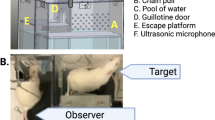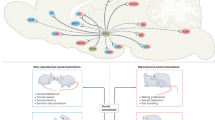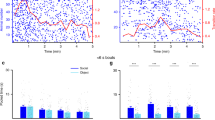Abstract
Empathy, the capacity for shared emotional valence with others, can allow for cooperativity and social bonding between individuals. However, clinical studies indicate it is dysregulated in neuropsychiatric disorders like autism and addiction, making a translationally relevant model of empathy extremely important. The evolutionary basis of the empathic behaviors observed across numerous species can be described using the Perception Action Model (PAM), in which shared affect can promote an action that eliminates the distress of both the “Target” and, by extension, the “Observer”. Increasing evidence suggests rodents will work to reduce the distress of a conspecific, but current models of helping behavior are unable to completely parse apart whether the reported behavior is driven by empathy or social reward. The current study demonstrates, using a novel behavioral model, rats learn to aid a distressed conspecific in the absence of social reward, retain the task over time, and previous experience increases the rate of task acquisition. Further, our model suggests that empathic behavior is subject to low effort as compared to a social reward. We next validated the specificity of this model to study empathic processes, characterized the importance of both the Target’s level of distress and the impact of the Observer’s familiarity with the Target on empathic behavior. Overall, we believe this model adheres to the PAM of empathy by eliminating the influence of social interaction. Importantly, it can be used to directly evaluate the neurocircuitry of empathy and explore the interplay between blunted empathic behavior and neuropsychiatric disorders.
Similar content being viewed by others
Log in or create a free account to read this content
Gain free access to this article, as well as selected content from this journal and more on nature.com
or
References
Meyza KZ, Bartal IB-A, Monfils MH, Panksepp JB, Knapska E. The roots of empathy: through the lens of rodent models. Neurosci Biobehav Rev. 2017;76:216–34.
Preston SD, de Waal FBM. Empathy: its ultimate and proximate bases. Behav Brain Sci. 2002;25:1–20. Discussion 20–71
de Waal FBM, Preston SD. Mammalian empathy: behavioural manifestations and neural basis. Nat Rev Neurosci. 2017;18:498–509.
Meyza K, Knapska E. What can rodents teach us about empathy? Curr Opin Psychol. 2018;24:15–20.
Sivaselvachandran S, Acland EL, Abdallah S & Martin LJ. Behavioral and mechanistic insight into rodent empathy. Neurosci Biobehav Rev. 2018;91:130–7.
Panksepp J, Panksepp JB. Toward a cross-species understanding of empathy. Trends Neurosci. 2013;36:489–96.
Church RM. Emotional reactions of rats to the pain of others. J Comp Physiol Psychol. 1959;52:132–4.
Rice GE, Gainer P. ‘Altruism’ in the albino rat. J Comp Physiol Psychol. 1962;55:123–5.
Sato N, Tan L, Tate K, Okada M. Rats demonstrate helping behavior toward a soaked conspecific. Anim Cogn. 2015;18:1039–47.
Ben-Ami Bartal I, Decety J, Mason P. Empathy and pro-social behavior in rats. Science. 2011;334:1427–30.
Ben-Ami Bartal I, Rodgers DA, Bernardez Sarria MS, Decety J, Mason P. Pro-social behavior in rats is modulated by social experience. Elife. 2014;3:e01385.
Hachiga Y, Schwartz LP, Silberberg A, Kearns DN, Gomez M, Slotnick B. Does a rat free a trapped rat due to empathy or for sociality? J Exp Anal Behav. 2018;110:267–74.
Silberberg A, Allouch C, Sandfort S, Kearns D, Karpel H, Slotnick B. Desire for social contact, not empathy, may explain “rescue” behavior in rats. Anim Cognition. 2014;17:609–18.
Decety J, Moriguchi Y. The empathic brain and its dysfunction in psychiatric populations: implications for intervention across different clinical conditions. Biopsychosoc Med. 2007;1:22.
Cook R, Brewer R, Shah P, Bird G. Alexithymia, not autism, predicts poor recognition of emotional facial expressions. Psychological Sci. 2013;24:723–32.
Bird G, Cook R. Mixed emotions: the contribution of alexithymia to the emotional symptoms of autism. Transl Psychiatry. 2013;3:e285.
Maurage P, et al. Dissociation between affective and cognitive empathy in alcoholism: a specific deficit for the emotional dimension. Alcohol Clin Exp Res. 2011;35:1662–8.
McCown W. The relationship between impulsivity, empathy and involvement in twelve step self-help substance abuse treatment groups. Br J Addiction. 1989;84:391–3.
McCown W. The effect of impulsivity and empathy on abstinence of poly-substance abusers: a prospective study. Br J Addiction. 1990;85:635–7.
Massey SH, Newmark RL, Wakschlag LS. Explicating the role of empathic processes in substance use disorders: a conceptual framework and research agenda. Drug Alcohol Rev. 2018;37:316–32.
Robinson CSH, Fokas K, Witkiewitz K. Relationship between empathic processing and drinking behavior in project MATCH. Addict Behav. 2018;77:180–6.
Lamm C, Decety J, Singer T. Meta-analytic evidence for common and distinct neural networks associated with directly experienced pain and empathy for pain. Neuroimage. 2011;54:2492–502.
Carvalheiro J, Seara-Cardoso A, Mesquita AR, de Sousa L, Oliveira P, Summavielle T, et al. Helping behavior in rats (Rattus norvegicus) when an escape alternative is present. J. Comp. Psychol. 2019;133:452–62.
Lockwood PL, Hamonet M, Zhang SH, Ratnavel A, Salmony FU, Husain M, et al. Prosocial apathy for helping others when effort is required. Nat Hum Behav. 2017;1:0131.
Cameron CD, Hutcherson CA, Ferguson AM, Scheffer JA, Hadjiandreou E, Inzlicht M. Empathy is hard work: people choose to avoid empathy because of its cognitive costs. J Exp Psychol Gen. 2019;148:962–76.
Cialdini RB, Brown SL, Lewis BP, Luce C, Neuberg SL. Reinterpreting the empathy-altruism relationship: when one into one equals oneness. J Personal Soc Psychol. 1997;73:481–94.
Levine M, Prosser A, Evans D, Reicher S. Identity and emergency intervention: how social group membership and inclusiveness of group boundaries shape helping behavior. Personal Soc Psychol Bull. 2005;31:443–53.
Echols S, Correll J. It’s more than skin deep: empathy and helping behavior across social groups. In: Decety, J, editor. Empathy: from bench to bedside. Cambridge: MIT Press; 2012. p. 55–71.
Batson CD, Lishner DA, Cook J, Sawyer S. Similarity and nurturance: two possible sources of empathy for strangers. Basic Appl Soc Psychol. 2005;27:15–25.
Mathur VA, Harada T, Lipke T, Chiao JY. Neural basis of extraordinary empathy and altruistic motivation. NeuroImage. 2010;51:1468–75.
Karakilic A, Kizildag S, Kandis S, Guvendi G, Koc B, Camsari GB, et al. The effects of acute foot shock stress on empathy levels in rats. Behavioural Brain Res. 2018;349:31–6.
Vanderschuren LJMJ, Achterberg EJM, Trezza V. The neurobiology of social play and its rewarding value in rats. Neurosci Biobehav Rev. 2016;70:86–105.
Lee A, Clancy S, Fleming AS. Mother rats bar-press for pups: Effects of lesions of the mpoa and limbic sites on maternal behavior and operant responding for pup-reinforcement. Behavioural Brain Res. 2000;108:215–31.
Trezza V, Campolongo P, Vanderschuren LJMJ. Evaluating the rewarding nature of social interactions in laboratory animals. Developmental Cogn Neurosci. 2011;1:444–58.
Calcagnetti DJ, Schechter MD. Place conditioning reveals the rewarding aspect of social interaction in juvenile rats. Physiol Behav. 1992;51:667–72.
Douglas LA, Varlinskaya EI, Spear LP. Rewarding properties of social interactions in adolescent and adult male and female rats: impact of social versus isolate housing of subjects and partners. Developmental Psychobiol. 2004;45:153–62.
Fritz M, El Rawas R, Salti A, Klement S, Bardo MT, Kemmler G, et al. Reversal of cocaine-conditioned place preference and mesocorticolimbic Zif268 expression by social interaction in rats. Addiction Biol. 2011;16:273–84.
Ikemoto S, Panksepp J. The effects of early social isolation on the motivation for social play in juvenile rats. Developmental Psychobiol. 1992;25:261–74.
Normansell L, Panksepp J. Effects of morphine and naloxone on play-rewarded spatial discrimination in juvenile rats. Developmental Psychobiol. 1990;23:75–83.
Yates JR, Beckmann JS, Meyer AC, Bardo MT. Concurrent choice for social interaction and amphetamine using conditioned place preference in rats: effects of age and housing condition. Drug Alcohol Depend. 2013;129:240–6.
Fritz M, Klement S, El Rawas R, Saria A, Zernig G. Sigma1 receptor antagonist BD1047 enhances reversal of conditioned place preference from cocaine to social interaction. Pharmacology. 2011;87:45–48.
Venniro M, Zhang M, Caprioli D, Hoots JK, Golden SA, Heins C, et al. Volitional social interaction prevents drug addiction in rat models. Nat Neurosci. 2018;21:1520–9.
Acknowledgements
The authors would like to thank Angela Kearns, Samantha Brown, Carole Berini, and Jordan Hopkins for their assistance in collecting preliminary data for this manuscript. We would also like to thank Drs. Rachel Penrod and Brett Froeliger for comments on an earlier draft of this manuscript.
Author information
Authors and Affiliations
Corresponding author
Additional information
Publisher’s note Springer Nature remains neutral with regard to jurisdictional claims in published maps and institutional affiliations.
Rights and permissions
About this article
Cite this article
Cox, S.S., Reichel, C.M. Rats display empathic behavior independent of the opportunity for social interaction. Neuropsychopharmacol. 45, 1097–1104 (2020). https://doi.org/10.1038/s41386-019-0572-8
Received:
Revised:
Accepted:
Published:
Issue date:
DOI: https://doi.org/10.1038/s41386-019-0572-8
This article is cited by
-
The role of the anterior insula during targeted helping behavior in male rats
Scientific Reports (2022)
-
Observation of rescue behaviour in wild boar (Sus scrofa)
Scientific Reports (2021)
-
Taking action: empathy and social interaction in rats
Neuropsychopharmacology (2020)
-
Affective dimensions of pain and region -specific involvement of nitric oxide in the development of empathic hyperalgesia
Scientific Reports (2020)



